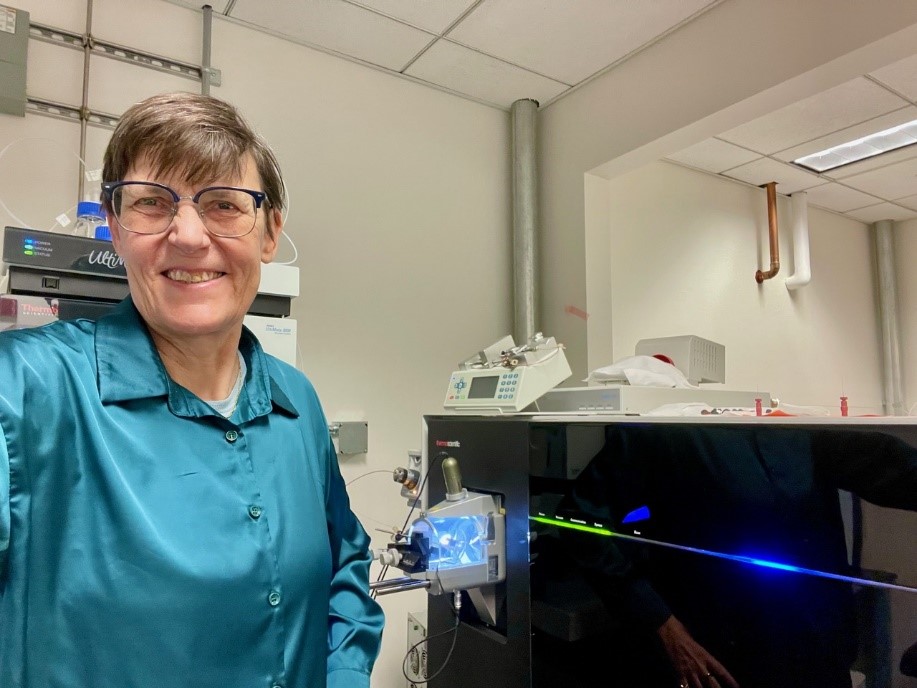S10 Mass Spectrometers Accelerate Collaborations on Aging and Women’s Health Research
Scientific and health innovations rely on continuous access to cutting-edge technology and instruments. Dr. Birgit Schilling, Professor, Buck Institute for Research on Aging, and Director of the Proteomics Core and Mass Spectrometry Center, knows this better than most, thanks to her dual role as a researcher and Core Director (Figure 1). When she started at the Buck Institute shortly after her postdoctoral fellowship, she was introduced to ORIP’s S10 Instrumentation Programs, which fund the purchase of state-of-the-art scientific instruments that are typically too expensive for an individual researcher to procure. Dr. Schilling noted that the S10 grants have been key to building the Buck Institute’s Proteomics Core and Mass Spectrometry Center, as well as to driving discovery for her research interests.

Dr. Schilling investigates aging using S10-funded mass spectrometers. “Mass spectrometry opens the door for identifying biomarkers to test function and direct phenotypic consequence for the cell and human body for aging,” Dr. Schilling explained. She and her collaborator, Dr. Gordon Lithgow, Professor, Buck Institute, have studied the accumulation of insoluble protein aggregates called amyloid beta, a hallmark of age-related neurogenerative diseases. They completed a systematic study in worms that demonstrates connections between amyloid beta in neurodegenerative diseases and aging.1
One challenge was visualizing this aggregation—brain biopsies can only be performed postmortem, and imaging the insoluble particles in tissue requires a costly and advanced positron emission tomography (PET) scanner. Dr. Schilling and her team developed mass spectrometry protocols to isolate insoluble proteins and identified different solubilization methods. They also demonstrated an intervention that could reverse the toxic effects of the aggregates by using compounds derived from natural products to boost mitochondrial health.
Dr. Schilling is passionate about the translational implications of her work for multiple age-related diseases, such as dementia and Alzheimer’s disease: “Aging is such an integral part of human life, and it affects all of us,” she noted. “There’s no way around it. The goal is to expand the health span rather than the lifespan.”
Dr. Schilling’s expertise in mass spectrometry and her access to advanced instruments have made her an ideal collaborator for researchers, even if their scientific focus is not aging. For example, Dr. Denis Wirtz, Vice Provost for Research and Theophilus Halley Smoot Professor, Johns Hopkins Whiting School of Engineering, found Dr. Schilling to be an ideal partner. Dr. Wirtz has created a fallopian tube assembloid—a 3D tissue model designed in the laboratory to mimic the structure and function of a native fallopian tube. He asked Dr. Schilling to use her proteomics expertise to validate whether the assembloid’s structure and actions resembled a native fallopian tube.
The two investigators and their respective teams compared the model’s molecular expression patterns and hormonal responses to standard fallopian tube organoids and tissue sections and structurally and functionally validated that the model accurately mimics native tissue.2 Using global proteomics, they confirmed the model’s ability to replicate cilia-driven transport of an oocyte, just like a real fallopian tube. Dr. Schilling noted that researchers have “very few preclinical models for fallopian tube biology, but many diseases originate in the fallopian tubes, like high-grade serous ovarian (HGSC) cancer.”
This model has laid the groundwork for in vitro studies of gynecological conditions and diseases, such as HGSC and ectopic pregnancy, and could have a profound impact on women’s health research. It has also opened the door to customized 3D in vitro models of other human organs, such as the pancreas. In the right hands, technology can forge connections and collaborations that traverse research areas. “I can pretty much work on any biological question you might have,” Dr. Schilling said. “Connecting with the right collaborators can really advance science.”
Dr. Schilling’s collaborations have a wide reach through her involvement in the Cellular Senescence Network (SenNet) Consortium, a program established by the NIH Common Fund in 2021 to study sex- and age-related differences in other human tissues. “Many [collaborations] are possible,” she says, “and I see the mass spectrometry in all of that. Many studies, if they are multimodal and use a lot of high-end technologies, can bring different components to validate the system. Connecting scientific colleagues from different fields makes science stronger, and collaboration is the key to science in general.”
Dr. Schilling is grateful for the S10 mechanism that encourages shared use of instruments and facilitates collaborations. By continuously fostering collaborations through technology expertise and instrument access, health research is accelerated. Ultimately, Dr. Schilling’s various collaborative findings are likely to benefit her aging research, as well. She believes the next step involves finding safe translational interventions for aging that have been evaluated in the human context, including model systems like the fallopian tube. Dr. Schilling’s commitment to science is not just for science’s sake but also to turn findings into something that impacts people’s lives. “We didn’t just want to publish a paper,” she says. “We wanted to create a model that was functional for other people to use to improve human health.”
ORIP’s S10 programs support purchases of state-of-the-art, commercially available instruments to enhance research of NIH-funded investigators. S10 awards are made to domestic public and private institutions of higher education, as well as nonprofit domestic institutions, such as hospitals, health professional schools, and research organizations. Every instrument funded by an S10 grant is to be shared with other institutions, which makes the programs cost efficient and beneficial to thousands of investigators in hundreds of institutions nationwide. For more information, please visit ORIP’s S10 Instrumentation Programs webpage.
References
1 Anderton E, Chamoli M, Bhaumik D, et al. Amyloid β accelerates age-related proteome-wide protein insolubility. Geroscience. 2024 Oct;46(5):4585–4602. doi:10.1007/s11357-024-01169-1.
2 Crawford AJ, Forjaz A, Bons J, et al. Combined assembloid modeling and 3D whole-organ mapping captures the microanatomy and function of the human fallopian tube. Sci Adv. 2024 Sep 27;10(39):eadp6285. doi:10.1126/sciadv.adp6285.



